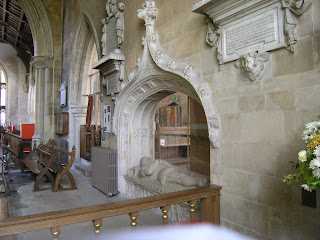Following the lunchtime discussion that this church had just been made redundant (source a friend of Andy), and Andy's detour here and discovery it was in fact open, JRS also came here from Barnack to record it, and so I felt I would try too, although approaching 6pm I thought it may be locked. It wasn't, and I discovered that JohnV had also detoured here after Uffington as he had signed the visitors' book. The church is impressively sited on a rise above the village, and reached from the road by a long path leading up to the east end with its odd paired Dec windows. From outside you could hear the noise from the local cricket club. Large spacious if rather bare interior. In the north aisle splendid large painted Commandment boards, Creed Lord's Prayer and above Royal Arms, all 1790. Several C17-C18 wall memorials, plus in the chancel a tomb with semi-reclining effigy of Bridget Lady Carre d1621. The chancel too has a fine series of early C20 windows.
As I photographed the outside the wind got up and I suddenly felt chilly. To my horror I realised I had left my sweat shirt and jacket hanging in the wardrobe at the B&B, so had to return to Aldwincle to collect them. Luckily this was not too much of a detour and the owners were thankfully at home. I celebrated my return to Bristol by buying a kebab and after eating it promptly fell asleep on the settee.
Thanks to everyone who attended the AGM for their company and repartee. And thanks especially to Chris Stafford for the organisation and planning of another successful day in his back garden, despite realising that family commitments in Pembrokeshire meant that he had to drive back from there for our day and return there for a further family event the following day. I am sure he uttered a few choice words when the wedding and christening got planned either side of the trip he had agreed to organise this year. And thanks also to Mrs S for giving him permission.




















































